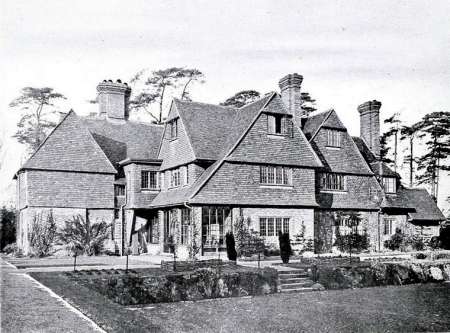Stonewall Cottage, Speldhurst Road, Langton Green, near Tunbridge Wells.
A Typical Kentish Farmstead Enlarged by Mr. P. Moiiey Harder Alteration of Plan to Secure Good Aspects A Farm Orchard as Material for a Garden. The Picturesqueness of Grouping which comes with Skilful Additions.
THE little Kentish farmstead at Langton Green, near Tunbridge Wells, was typical in its original plan (Fig. 116), but during a period, when it was divided into two cottages, it had been robbed of any features of interest save its oak-framed walls, hung with richly weathered tiles, and an attractive circular newel staircase. When Mr. Morley Horder undertook the reparation of this little place, the problems to be solved were not few. It stood below the road and too near it to be altogether pleasant, and the aspect was difficult because the sunny side afforded the least attractive outlook. He, therefore, re arranged it as follows: The main entrance was changed from the western road front to the north side, where a small enclosed court w a s formed (Fig. 109). The ground was filled up here so that the new buildings might be reached from the level of the road. The old farmyard entry was turned into a paved sunk garden, and a high fence and planting give it privacy from the main road. The drawing and dining rooms were thrown out towards the east and west so that each might have at least one window to the south. The old cottage was transformed into hall and smoking-room, and part of the former was carried up to form a gallery, which shows the fine old oak framing (Fig. 112). The old barn on the roadside serves well as stable and garage, and the oasthouse remains as an interesting feature in the garden. It is shortly to be turned into a billiard-room and play-room, with possibly a connecting passage to the house. The old farm garden with its small orchard trees has quickly lent itself to developments in a way which no ordinary new building site could do. It is to such a fact as this that we must ascribe the appeal of Stonewall Cottage and other little places of its kind; it is largely because settled conditions of age can so soon be achieved. The craze for old cottages can be carried to extremes, but, after all, there are signs of grace in the respect paid to a lichenous roof and a gnarled apple tree. The additions were begun in a modest way, and grew when the present owner, Mr. Apperley, acquired the property while it was in process of alteration. In this case the added rooms cover a far larger area than the original little building. It might reasonably be urged that the cottage would have been more convenient in its plan but for the problems set up by the old fabric, now incorporated with the new. An entirely new house would probably have involved less expense, but the problem of subordinating new additions to even so small an existing house often leads to a pleasant irresponsibility of grouping not to be achieved easily in a new house of like size.
Reference Lawrence Weaver: Small Country Houses: Their Repair and Enlargement. 1914 Page 76-80
Listed Grade II as Searles and Stonewall
